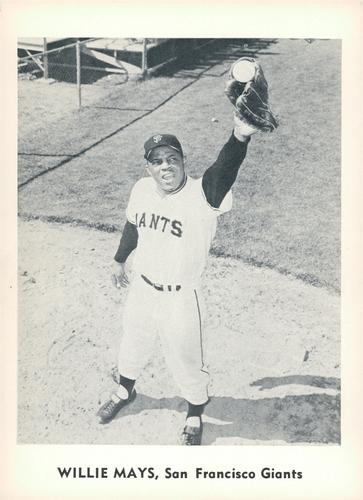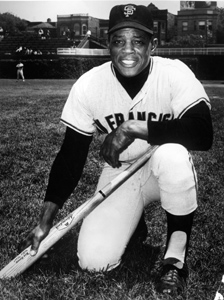July 11-13, 1960: Willie Mays hits for the cycle in All-Star doubleheader
 In his second at-bat of the second All-Star Game in 1960, Willie Mays made history by completing the All-Star Game cycle. In the span of just two days, Mays had collected the four necessary hits to hit for the cycle: a single, double, triple, and home run. No major leaguer has ever hit for the cycle in one All-Star Game. Mays became the first (and only) ballplayer to hit for the cycle in an All-Star doubleheader, when both games were played in the same season.
In his second at-bat of the second All-Star Game in 1960, Willie Mays made history by completing the All-Star Game cycle. In the span of just two days, Mays had collected the four necessary hits to hit for the cycle: a single, double, triple, and home run. No major leaguer has ever hit for the cycle in one All-Star Game. Mays became the first (and only) ballplayer to hit for the cycle in an All-Star doubleheader, when both games were played in the same season.
From 1959 through 1962, a four-season experiment, there were two All-Star Games played each year. Why? According to MLB.com writer Bill Center, “Profits from the second All-Star Game went directly into the players’ pension fund under the Collective Bargaining Agreement with the Major League Baseball Players Association.”1 In 1960 the games were only two days apart (July 11 and 13), and they were played in two American League venues (Kansas City’s Municipal Stadium and New York’s Yankee Stadium).
The gametime temperature at Yankee Stadium was 88 degrees, but it was very humid. Still, this was 12 degrees cooler than it had been in Kansas City,2 where the National League handily defeated the American League, 5-3, before a crowd of 30,619. Pittsburgh’s Bob Friend started for the NL and pitched three one-hit, shutout innings. Friend had tied for the major-league lead in wins in 1958 with 22 wins; he also tied for the most losses (with 19) the following season.3 He rebounded in 1960, winning 10 games in the season’s first half to gain his third All-Star selection.
For the AL, Boston’s Bill Monbouquette started; he had won eight games coming into the All-Star break. The Red Sox right-hander was tagged for four runs on five hits in just the first two frames. Mays led all batters with a 3-for-4 performance, consisting of a single, double, and triple. He made four putouts in center field.
The starting pitchers in Game Two were the Yankees’ Whitey Ford and the Pirates’ Vern Law. Ford had struggled a bit in the first half of the season, winning only five of 10 decisions. His ERA was over three runs per nine innings, higher than in any of his first eight seasons with New York. But he was the Yankees’ ace, and the game was in New York. Law and Friend were the stars of the Pirates staff. Law had won 11 games leading up to the break, with a 2.52 ERA. A crowd of 38,362 came through the gates of Yankee Stadium.
Before the game, Mays supposedly joked with American League All-Star Yogi Berra, “Hey Yog. Do you mind if I steal on you?”4 Berra responded with “Go ahead, Willie.” Mays swung at the first pitch of the game, singling to left field. Bob Skinner banged a Baltimore chop for another hit, and Mays advanced to second. With Hank Aaron in the batter’s box, Mays “expressed his talent for baseball larceny”5 and stole third base. On the next pitch, Skinner broke for second on a missed hit-and-run. Berra faked the throw to second and instead threw to third base, as Mays came down the line toward home. According to the New York Times, Berra “hung him up on the third-base line, as exposed as the Monday wash,”6 and later told reporters, “That’ll learn yuh not to go horsin’ around with me.”7
The senior circuit squad tallied in the second inning. Joe Adcock led off with a single and Eddie Mathews followed with a homer. Law faced the minimum through two innings. Although Bill Skowron singled with one out in the bottom of the second, Berra hit a comebacker to Law, who started a double play to end the inning.
Mays led off the third inning facing Ford for the second time. He swung at a curve that was low and away and “blasted a towering homer deep into the lower left-field stands,”8 extending the NL advantage to 3-0. Ford told reporters that Mays “just reached out and pulled the ball into the seats.”9 With the round-tripper, Mays had completed hitting for the All-Star Game cycle in just his sixth at-bat.
With Johnny Podres now pitching, the AL loaded the bases with a single and a pair of walks in the bottom of the third, but Roger Maris popped out to the catcher for the third out. The score remained 3-0 until the top of the seventh. Perennial All-Star Stan Musial pinch-hit for pitcher Stan Williams and belted a homer well beyond the right-field barrier. It was his sixth All-Star Game home run.
In the home half of the seventh, Maris had another chance to put the AL on the scoreboard. Larry Jackson was now on the mound. Frank Malzone walked and two outs later, Ted Williams singled. Brooks Robinson entered as a pinch-runner for 41-year-old Williams, playing in his final season. Jackson walked Al Kaline to load the bases, bringing Maris to the plate. This was his second at-bat with the bases loaded. Maris hit a fly ball to center that “enabled Mays to treat his admirers to one of his familiar basket catches.”10 Mays played the game with a glove borrowed from Roy Face, saying, “Somebody stole my glove in Kansas City.”11 Showing the glove to reporters, he said, “Look at it. It’s a little boy’s glove.”12
Mays led off the top of the eighth. In the fifth he had popped out to first baseman Skowron, but in the eighth he singled to center to start a rally, An out later, Roberto Clemente walked, but Dick Groat, pinch-hitting for Ernie Banks, grounded into an inning-ending 4-6-3 double play. Vada Pinson entered the game, replacing Mays in center. Mickey Mantle singled to begin the bottom of the eighth. After Vic Power flied out, Sherm Lollar lined a ball to right field that bounced over the fence for a ground-rule double. Mantle had to hold at third base. Bill Henry retired the next two batters to preserve the shutout.
The NL team had a little magic left. Norm Larker started the ninth inning with a walk. Ken Boyer followed with a blast to deep left for a two-run homer. The Nationals led, 6-0. Two more batters reached in the ninth, but no more would score. Lindy McDaniel came on to pitch the bottom of the ninth for the NL. Although Kaline managed a single, McDaniel retired the other three batters he faced with groundballs. Maris ended the game with a grounder to first. In three at-bats, the 1960 Most Valuable Player had left seven men on base.
The National League team had swept the 1960 All-Star doubleheader, giving them nine wins in the past 13 contests. In this second game, they had scored six runs, all driven in by the long ball; hit by four different stars: Mathews, Mays, Musial, and Boyer. The American Leaguers had been held to eight hits, all singles except Lollar’s double.
Combining his totals for the two 1960 All-Star Games, Mays batted .750, getting six hits in eight at-bats. Those hits included the four necessary for a cycle. His OPS was 2.250! He drove in a run and scored twice. Al Lopez, skipper for the American League team, said, “We didn’t have a pitching book on Willie Mays.”13
In his career, Mays played in 24 All-Star Games, including two each year from 1959 to 1962. As of the 2022 season, Mays still held the record for most career singles (15) in All-Star Games. In addition, he clouted two doubles, three triples, and three home runs.
Ted Williams was obviously not happy with the two losses, but he told the press, “There’s nothing much wrong with playing two All-Star Games. Any guy who’s a ballplayer wants to play ball.”14
Author’s note
Mays’ historic feat is phenomenal, considering that he accomplished hitting for the cycle in the same season’s All-Star Games. His sequence for the four hits needed was triple-single-double-home run.15
Other players have accomplished a career All-Star Game cycle, including Ernie Banks, Roberto Clemente, Ted Williams, Mike Schmidt, Steve Garvey, Lou Whitaker, George Brett, Prince Fielder and Mike Trout. In the two 1960 games, Banks was 3-for-7, collecting a single, double, and home run, putting him just a triple shy of tying Mays’ historic mark.
Just over a half-century after Mays, Trout hit for a natural All-Star cycle16 in four consecutive All-Star Games. In 2012 he singled against R.A. Dickey in the sixth inning (and then stole second base). In 2013 he doubled to right off Matt Harvey to lead off the game. In 2014 he tripled to center field on a full count off Adam Wainwright in the top of the first, driving in a run; he also doubled to left in the fifth inning. In 2015, again leading off the game, he homered on a line drive off Zack Greinke, to complete the career All-Star Game cycle.
SOURCES
In addition to the sources mentioned in the Notes, the author consulted Baseball-Reference.com, MLB.com, Retrosheet.org, and SABR.org.
https://www.baseball-reference.com/allstar/1960-allstar-game-1.shtml
https://www.retrosheet.org/boxesetc/1960/B07110ALS1960.htm
https://www.baseball-reference.com/allstar/1960-allstar-game-2.shtml
https://www.retrosheet.org/boxesetc/1960/B07130ALS1960.htm
NOTES
1 Bill Center, “Leagues Split Two All-Star Games Played in 1959,” found online at www.mlb.com/news/leagues-split-two-all-star-games-in-1959-c163719750. Accessed September 2022. Center also wrote, “The result didn’t exactly measure up to the level of Midsummer Classics, and the dual All-Star Game experiment ended in 1962.” New York Times writer Leonard Koppett denounced the two-game idea, writing that the “[p]layers had revealed themselves in a mercenary light.” See Leonard Koppett, “All-Star Review: Ho-Hum Affair,” New York Times, July 25, 1974: 39.
2 John Drebinger, “Mays Stands Out in 6-0 Contest,” New York Times, July 14, 1960: 30.
3 Warren Spahn had 22 wins for the Milwaukee Braves in 1958, while Pedro Ramos had 19 losses with the Washington Senators in 1959.
4 Arthur Daley, “Sports of the Times,” New York Times, July 14, 1960: 14.
5 Lou Hatter, “N.L. Wallops Four Home Runs to Defeat A.L. All-Stars, 6 to 0,” Baltimore Sun, July 14: 22.
6 Daley.
7 Daley.
8 Daley.
9 Louis Effrat, “Pitching Shares in Victory Credit,” New York Times, July 14, 1960: 30.
10 Drebinger.
11 Daley.
12 Daley. Face was 5-feet-8, 155 pounds.
13 “A.L. Lacked Mays’s ‘Book,’” Baltimore Sun, July 14: 19.
14 Hatter.
15 As of the 2022 All-Star break, the triple-single-double-home run (3-1-2-4) sequence of hits is one of the rarest in regular-season play, occurring in just 10 of the 316 known sequences (3.16 percent). Of the 339 official cycles in major-league history to this date, the sequence of hits is known for only 316 games Almost all of the unknown sequences took place in nineteenth-century games, where play-by-play is not available and newspaper recaps of the games are vague. Only two other sequences (2-3-4-1 and 4-2-3-1) have occurred less frequently than that hit by Mays.
16 A natural cycle occurs when the batter gets the hits (single, double, triple, and home run) in that order.
Additional Stats
National League 5
American League 3
National League 6
American League 0
Municipal Stadium
Kansas City, MO
Yankee Stadium
New York, NY
Box Score + PBP:
Game 1:
Game 2:
Corrections? Additions?
If you can help us improve this game story, contact us.


